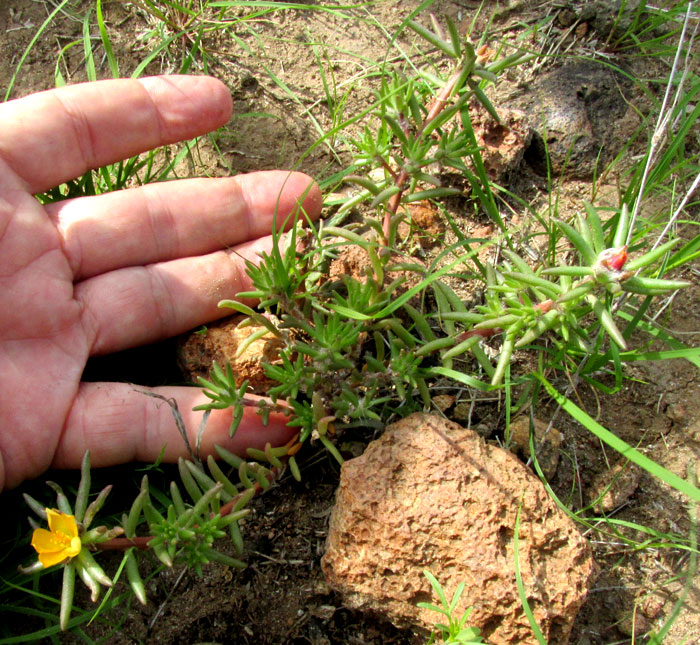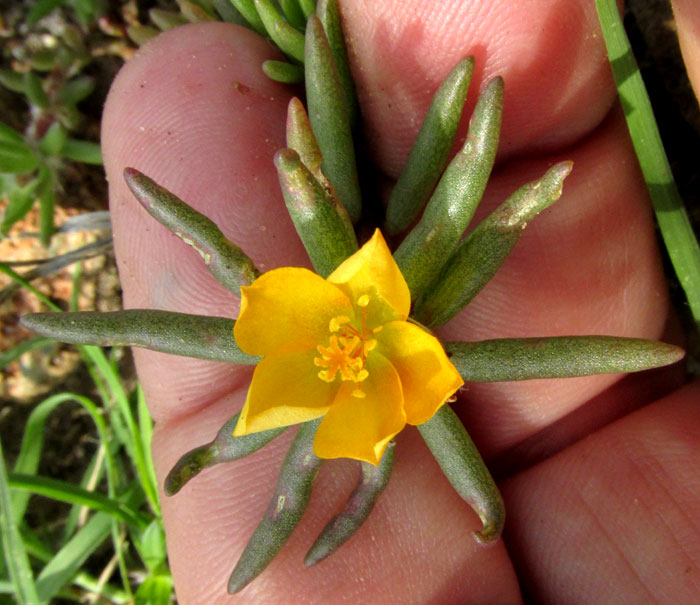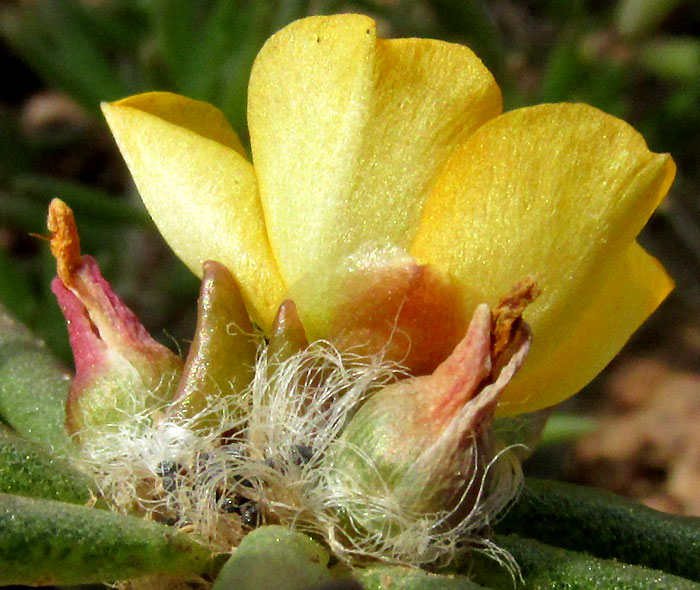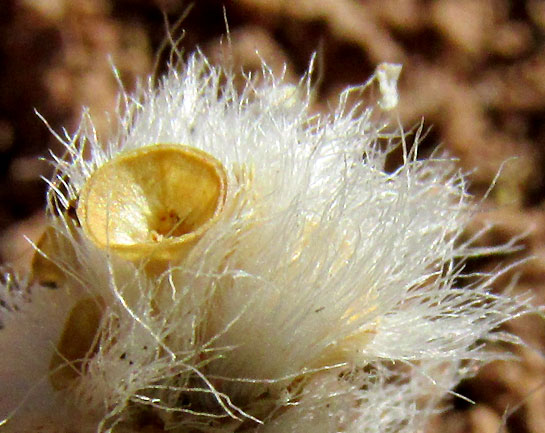Excerpts from Jim Conrad's
Naturalist Newsletter
entry dated August 31, 2022, issued from near Tequisquiapan, elevation about 1,900m (6200 ft), N20.565°, W99.890°, Querétaro state, MÉXICO
PORTULACA MEXICANA

In very shallow dirt developed atop bedrock composed of compacted volcanic ash mixed with sediment washed from nearby hills of volcanic rhyolite, in a grossly overgrazed, eroded field a couple of weeks after the rainy season's first two-month-late rains, the above plant was doing very well. Its yellow flowers and succulent leaves, round in cross-section, short and spiky, were similar to certain stonecrop species often found on boulders and exposed bedrock.

The stem's upper leaves nicely highlighted the flower, but something about the flower wasn't right for this to be a stonecrop. Here's a closer look:

The starfish-like item consists of several stigmas joined at their base atop a single short style atop a single ovary. Stonecrops, genus Sedum in the Stonecrop Family, the Crassulaceae, have several ovaries in each flower, each ovary with just one style and one stigma -- the opposite to what we're seeing.
Disabused of our first impression, more insight was sought:

The faded flowers with their calyxes swollen with spherical ovaries maturing into fruits, and those long, white hairs, as well as the flower's yellow color, and the fact that nowadays the rains have brought on a bounteous crop of wild Purslane which I eat plenty of each day, now I get it: Purslane is the genus Portulaca, which also has succulent leaves and with just one yellow blossom opening each day, and that flower produces starfish-like stigmas, and its capsular fruits are spherical. This must be another species of purslane.
Common, highly edible Purslane is Portulaca oleraceae, with a worldwide distribution in temperate to warm regions. What we have here is PORTULACA MEXICANA, occurring from here in central Mexico south through Mexico and Central America into northern Colombia. It has no regularly accepted English name, but being a genuine Portulaca and with the species name of mexicana, how can it be known in English as anything but Mexican Purslane?
Common Purslane often is touted as containing the highest concentration of omega-3 fatty acids and antioxidants of all green leafy vegetables. However, I find no mention of our plant being eaten. Its slender leaves just don't have much substance to them, and why eat this species when there's so much Common Purslane all around us?
There seems to be some uncertainty about our plant's name, even though currently the WorldFloraOnline.Org website lists Portulaca mexicana as acceptable. That may be because in recent years no one has looked closely at the matter. The Flora del Valle de Mexico suggests that our Portulaca mexicana and the more commonly occurring Portulaca pilosa may be the same thing, just that our Mexican Purslane bears yellow flowers, while the latter produces red or reddish ones. It's noted that the name Portulaca pilosa is the older, meaning that if modern studies indicate that the yellow and red flowered forms are the same, our yellow-flowered plants will become Portulaca pilosa, distributed from the US south into South America. And, somehow, Portulaca pilosa has acquired the English name of Kiss-Me-Quick!
entry dated December 20, 2022, issued from near Tequisquiapan, elevation about 1,900m (6200 ft), N20.565°, W99.890°, Querétaro state, MÉXICO
LOOKING LIKE POPCORN

At the edge of a small village the floor of a pit dug for fill-dirt, shown above, looked like it was strewn with popcorn. It's been droughty here, and in a certain area the pit's surface, fully exposed to sunlight and wind, was little more than packed dust. Here's a closer look at the popcorn:

Up closer still:

Species of the genus Portulaca produce egg-shaped, capsular fruits which, different from the vast majority of capsular fruits, in order to release their seeds, split around the capsule's equator, not from top to bottom. Such splitting is referred to as "circumscissile dehiscence." Above we see the bottom half of a dehisced fruit, the small, roundish seeds already dispersed.
But it's the white hairs that draw our attention. In the earlier entry we saw how these white hairs surround the base of the flowers, so this is what happens when our annual species has finished its life cycle, died, and dried out. Portulaca mexicana is a very variable species, with its growth habit much influenced by the habitat. The Flora of North America says of this species that "Plants growing in dry habitats have the greatest density of hairs... Plants in cool, dry habitats grow erect first, then branch more slowly; the plant then has a compact habit.
At first not recognizing which Portulaca species this might be, with a finger I dug into the dust to see if our plants might be perennial, maybe with a taproot. I went down nearly the length of a finger and found only the stem, apparently having been buried beneath the soil either by wind-carried dust or water-deposited silt, the stem tip growing upward as dirt gathered around it below. Our popcorn was just the fuzzy, fruiting tips of an herb's mostly submerged stem.
The 1994 study by M.J.A. Rocha and others entitled "Effects of hydroalcoholic extracts of Portulaca pilosa and Achyrocline satureioides on urinary sodium and potassium excretion" says that Portulaca pilosa -- which P. mexicana may be just a form of -- has been used in Brazil as a traditional remedy for certain kidney related problems. They write of their findings, "The results support the claim that extracts of P. pilosa present renal effects but not the popular belief that it affects diuresis. It has also been proved that, in rats, it causes an increase in K excretion without a concomitant change in water diuresis or Na excretion." K is potassium, and Na is sodium.